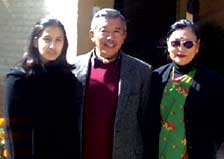 On a hilltop overlooking Kathmandu, a few minutes uphill from the sleeping Vishnu at Budhanilkantha, is a house that Bharat Rai calls his dream house. You don't see it until it is right in front of you, and even then it looks like a typical Nepali hill house. So what's so special about it?
On a hilltop overlooking Kathmandu, a few minutes uphill from the sleeping Vishnu at Budhanilkantha, is a house that Bharat Rai calls his dream house. You don't see it until it is right in front of you, and even then it looks like a typical Nepali hill house. So what's so special about it?
It is cosy, airy, bright, elegant and comfortable. And get this: it cost only Rs 500,000 to build. So why are people constructing mammoth mansions in Bhaisepati with corinthian columns and Greco-Roman arches in Beverly Hills-style villas that cost Rs 50 million? Ask them.
Bharat Rai is an enthusiastic lover of tradition and culture. Twenty years ago when Budhanilkantha was the boondocks, the son of a Gurkha soldier had the nerve to buy just over one hectare of land at an unbelievable Rs 125,000. The land was too rocky for agriculture and the farmer sold it for a song.
Rai dreamed that he would build a modern house that had no pretensions of being Nepali, just a nice comfortable house with full modern amenities. Using locally available labour and materials, he began building a house with the help of a German architect. He used the abundant stones in his property, employed the south-facing slope for maximum sunlight. It was a spacious and bright house, and with his interest in gardening and horticulture, Rai raised an orchard in the slope below the house.
 But something was still missing. "We come from the hills and we need to have a bit of the culture around us, and the house just wasn't Nepal. I still wanted a Nepali house." Eventually, Rai's family moved closer to the town because of his daughter's education, and he rented outhis house.
But something was still missing. "We come from the hills and we need to have a bit of the culture around us, and the house just wasn't Nepal. I still wanted a Nepali house." Eventually, Rai's family moved closer to the town because of his daughter's education, and he rented outhis house.
The tenant turned out to be a god-send: a former Peace Corps volunteer who had spent five years in Gorkha in the early 1970s who shared Rai's passion for traditional Nepali houses. The two got together and started plotting. Consulting their architect friends, Rai and his tenant went out to the hills on the fringes of the Shivapuri reserve taking pictures of traditional houses from all sides. They drew the plan: a simple rectangular house that took advantage of the slope for a split-level two storey house with Nepali tile roof. The beams and floor are made of wood, the outside is coated with cement mixed with mud to give it a traditional look that is also durable. Everything except the cement was made from locally available materials, and the elegant building is now a guesthouse for Rai's tenant, Nick Langton, who is director in Kathmandu of the Asia Foundation.
 Both Rai and Langton are ecstatic with the result. "This is exactly like I had visualised it: a low cost house, that blends with the surroundings, is simple and comfortable." Listening to the laments of Kathmandu-based expats about the lack of spacious, comfortable and traditional houses it is a wonder why more people do not follow Bharat Rai's example. He asks: "Why do Nepalis who want to rent their homes think that foreigners want to live in those ugly ostentatious buildings?"
Both Rai and Langton are ecstatic with the result. "This is exactly like I had visualised it: a low cost house, that blends with the surroundings, is simple and comfortable." Listening to the laments of Kathmandu-based expats about the lack of spacious, comfortable and traditional houses it is a wonder why more people do not follow Bharat Rai's example. He asks: "Why do Nepalis who want to rent their homes think that foreigners want to live in those ugly ostentatious buildings?"
In fact, it would make perfect business sense for Nepali home builders to invest more on traditional houses with modern amenities-there is a better chance of renting it out. For Rai, who has always been an old-fashioned traditionalist, this is just common sense. He has now got together with some partners to set up a private forest in Chitwan to grow hardwood sisau trees. "It is a long term investment but to take care of that we have let people cultivate herbs, and cash crops such as ginger on the forest floor," he says. "We have to keep asking ourselves, is what we do good for the land? Will it last? Will it set a good example?"
Rai, for one, has certainly found the right answers to all these questions and is setting an example by doing. And using his common sense.


